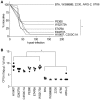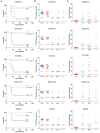Immunization with the MipA, Skp, or ETEC_2479 Antigens Confers Protection against Enterotoxigenic E. coli Strains Expressing Different Colonization Factors in a Mouse Pulmonary Challenge Model
- PMID: 28018863
- PMCID: PMC5149512
- DOI: 10.3389/fcimb.2016.00181
Immunization with the MipA, Skp, or ETEC_2479 Antigens Confers Protection against Enterotoxigenic E. coli Strains Expressing Different Colonization Factors in a Mouse Pulmonary Challenge Model
Abstract
Achieving cross-protective efficacy against multiple bacterial strains or serotypes is an important goal of vaccine design. Enterotoxigenic Escherichia coli (ETEC) is an important cause of diarrheal disease in underdeveloped nations. We have been interested in identifying and characterizing ETEC antigens that generate protective immune responses independent of ETEC colonization factor (CF) expression. Our previous studies used proteomics to identify the ETEC MipA, Skp, and ETEC_2479 proteins as effective in protecting mice from homologous challenge with ETEC H10407 using a pulmonary inoculation model. This model permits analysis of mouse survival, bacterial clearance, and the production of secretory IgA (sIgA) and has been employed previously for studies of enteric pathogens for which robust oral challenge models do not exist. MipA belongs to a family of proteins involved in remodeling peptidoglycan. Skp rescues misdirected outer membrane proteins. ETEC_2479 is predicted to function as an outer membrane porin. These proteins are conserved in pathogenic ETEC strains as well as in commensal Proteobacteria. Antibodies produced against the ETEC MipA, Skp, and ETEC_2479 proteins also reduced the adherence of multiple ETEC strains differing in CF type to intestinal epithelial cells. Here we characterized the ability of 10 heterologous ETEC strains that differ in CF type to cause clinical signs of illness in mice after pulmonary challenge. ETEC strains C350C1A, E24377A, E7476A, WS2173A, and PE360 caused variable degrees of lethality in this mouse model, while ETEC strains B7A, WS6866B, 2230, ARG-2, and 8786 did not. Subsequent challenge experiments in which mice were first vaccinated intranasally with MipA, Skp, or ETEC_2479, when combined with cholera toxin, showed both that each antigen was protective and that protection was strongly correlated with fecal IgA concentrations. We conclude that the MipA, Skp, or ETEC_2479 antigens generate protection in the mouse pulmonary challenge model against ETEC strains that express different CFs.
Keywords: ETEC; antigens; colonization factor; intranasal immunization; vaccines.
Figures


Similar articles
-
Immunization With Skp Delivered on Outer Membrane Vesicles Protects Mice Against Enterotoxigenic Escherichia coli Challenge.Front Cell Infect Microbiol. 2018 May 1;8:132. doi: 10.3389/fcimb.2018.00132. eCollection 2018. Front Cell Infect Microbiol. 2018. PMID: 29765911 Free PMC article.
-
Protective Enterotoxigenic Escherichia coli Antigens in a Murine Intranasal Challenge Model.PLoS Negl Trop Dis. 2015 Aug 5;9(8):e0003924. doi: 10.1371/journal.pntd.0003924. eCollection 2015. PLoS Negl Trop Dis. 2015. PMID: 26244636 Free PMC article.
-
Over-expression of major colonization factors of enterotoxigenic Escherichia coli, alone or together, on non-toxigenic E. coli bacteria.Vaccine. 2010 Oct 8;28(43):6977-84. doi: 10.1016/j.vaccine.2010.08.047. Epub 2010 Aug 20. Vaccine. 2010. PMID: 20728524
-
Strategies to overexpress enterotoxigenic Escherichia coli (ETEC) colonization factors for the construction of oral whole-cell inactivated ETEC vaccine candidates.Appl Microbiol Biotechnol. 2012 Mar;93(6):2291-300. doi: 10.1007/s00253-012-3930-6. Epub 2012 Feb 16. Appl Microbiol Biotechnol. 2012. PMID: 22350259 Review.
-
Review on pathogenicity mechanism of enterotoxigenic Escherichia coli and vaccines against it.Microb Pathog. 2018 Apr;117:162-169. doi: 10.1016/j.micpath.2018.02.032. Epub 2018 Feb 21. Microb Pathog. 2018. PMID: 29474827 Review.
Cited by
-
The Immunogenicity and Properties of a Whole-Cell ETEC Vaccine Inactivated with Psoralen and UVA Light in Comparison to Formalin.Microorganisms. 2023 Aug 9;11(8):2040. doi: 10.3390/microorganisms11082040. Microorganisms. 2023. PMID: 37630600 Free PMC article.
-
Salmonella Typhimurium Adhesin OmpV Activates Host Immunity To Confer Protection against Systemic and Gastrointestinal Infection in Mice.Infect Immun. 2021 Jul 15;89(8):e0012121. doi: 10.1128/IAI.00121-21. Epub 2021 Jul 15. Infect Immun. 2021. PMID: 34097470 Free PMC article.
-
Immunization With Skp Delivered on Outer Membrane Vesicles Protects Mice Against Enterotoxigenic Escherichia coli Challenge.Front Cell Infect Microbiol. 2018 May 1;8:132. doi: 10.3389/fcimb.2018.00132. eCollection 2018. Front Cell Infect Microbiol. 2018. PMID: 29765911 Free PMC article.
-
Dual-Use Vaccine for Diarrhoeal Diseases: Cross-Protective Immunogenicity of a Cold-Chain-Free, Live-Attenuated, Oral Cholera Vaccine against Enterotoxigenic Escherichia coli (ETEC) Challenge in BALB/c Mice.Vaccines (Basel). 2022 Dec 16;10(12):2161. doi: 10.3390/vaccines10122161. Vaccines (Basel). 2022. PMID: 36560571 Free PMC article.
References
Publication types
MeSH terms
Substances
Grants and funding
LinkOut - more resources
Full Text Sources
Other Literature Sources
Medical
Research Materials
Miscellaneous

